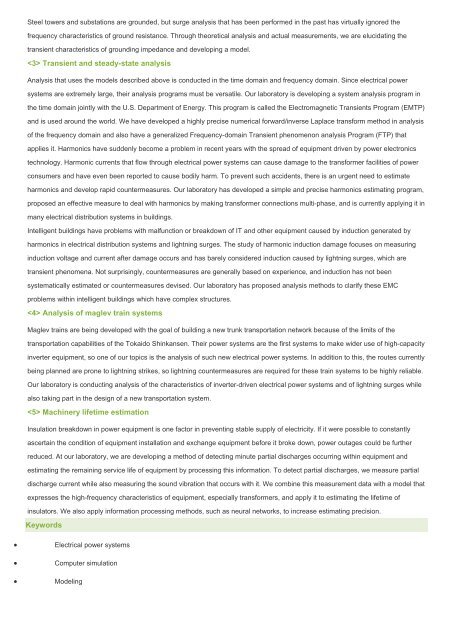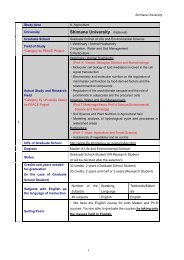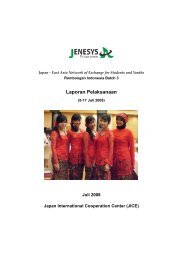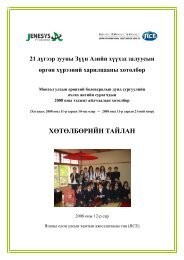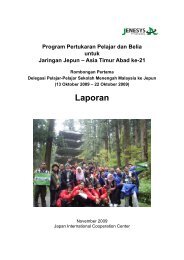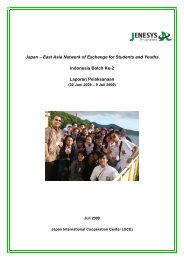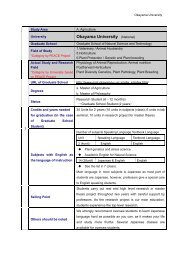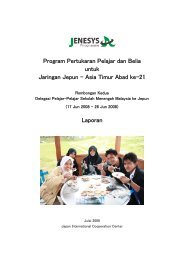Doshisha University (Private)
Doshisha University (Private)
Doshisha University (Private)
Create successful ePaper yourself
Turn your PDF publications into a flip-book with our unique Google optimized e-Paper software.
Steel towers and substations are grounded, but surge analysis that has been performed in the past has virtually ignored the<br />
frequency characteristics of ground resistance. Through theoretical analysis and actual measurements, we are elucidating the<br />
transient characteristics of grounding impedance and developing a model.<br />
Transient and steady-state analysis<br />
Analysis that uses the models described above is conducted in the time domain and frequency domain. Since electrical power<br />
systems are extremely large, their analysis programs must be versatile. Our laboratory is developing a system analysis program in<br />
the time domain jointly with the U.S. Department of Energy. This program is called the Electromagnetic Transients Program (EMTP)<br />
and is used around the world. We have developed a highly precise numerical forward/inverse Laplace transform method in analysis<br />
of the frequency domain and also have a generalized Frequency-domain Transient phenomenon analysis Program (FTP) that<br />
applies it. Harmonics have suddenly become a problem in recent years with the spread of equipment driven by power electronics<br />
technology. Harmonic currents that flow through electrical power systems can cause damage to the transformer facilities of power<br />
consumers and have even been reported to cause bodily harm. To prevent such accidents, there is an urgent need to estimate<br />
harmonics and develop rapid countermeasures. Our laboratory has developed a simple and precise harmonics estimating program,<br />
proposed an effective measure to deal with harmonics by making transformer connections multi-phase, and is currently applying it in<br />
many electrical distribution systems in buildings.<br />
Intelligent buildings have problems with malfunction or breakdown of IT and other equipment caused by induction generated by<br />
harmonics in electrical distribution systems and lightning surges. The study of harmonic induction damage focuses on measuring<br />
induction voltage and current after damage occurs and has barely considered induction caused by lightning surges, which are<br />
transient phenomena. Not surprisingly, countermeasures are generally based on experience, and induction has not been<br />
systematically estimated or countermeasures devised. Our laboratory has proposed analysis methods to clarify these EMC<br />
problems within intelligent buildings which have complex structures.<br />
Analysis of maglev train systems<br />
Maglev trains are being developed with the goal of building a new trunk transportation network because of the limits of the<br />
transportation capabilities of the Tokaido Shinkansen. Their power systems are the first systems to make wider use of high-capacity<br />
inverter equipment, so one of our topics is the analysis of such new electrical power systems. In addition to this, the routes currently<br />
being planned are prone to lightning strikes, so lightning countermeasures are required for these train systems to be highly reliable.<br />
Our laboratory is conducting analysis of the characteristics of inverter-driven electrical power systems and of lightning surges while<br />
also taking part in the design of a new transportation system.<br />
Machinery lifetime estimation<br />
Insulation breakdown in power equipment is one factor in preventing stable supply of electricity. If it were possible to constantly<br />
ascertain the condition of equipment installation and exchange equipment before it broke down, power outages could be further<br />
reduced. At our laboratory, we are developing a method of detecting minute partial discharges occurring within equipment and<br />
estimating the remaining service life of equipment by processing this information. To detect partial discharges, we measure partial<br />
discharge current while also measuring the sound vibration that occurs with it. We combine this measurement data with a model that<br />
expresses the high-frequency characteristics of equipment, especially transformers, and apply it to estimating the lifetime of<br />
insulators. We also apply information processing methods, such as neural networks, to increase estimating precision.<br />
Keywords<br />
<br />
<br />
<br />
Electrical power systems<br />
Computer simulation<br />
Modeling


